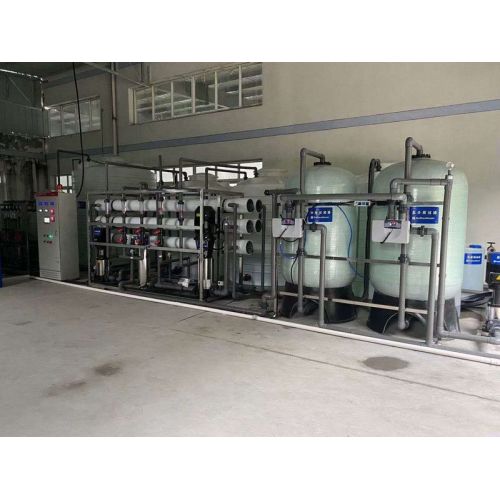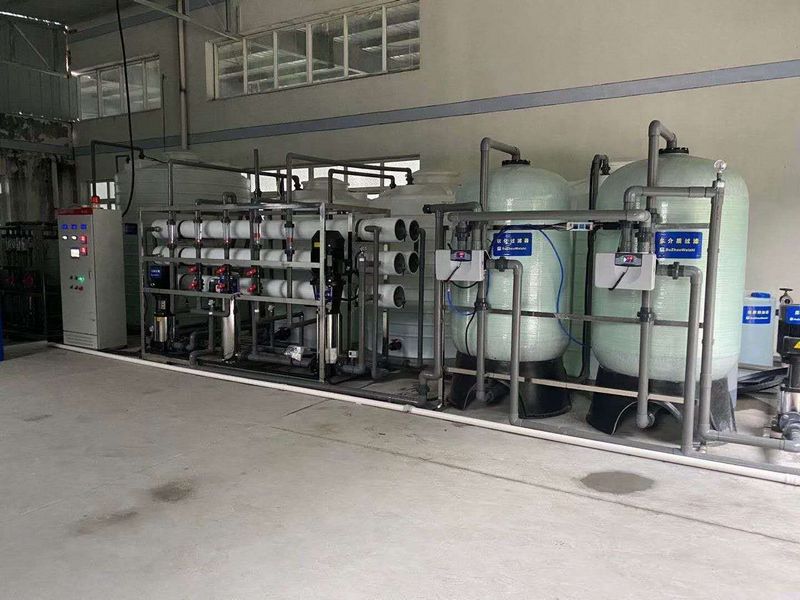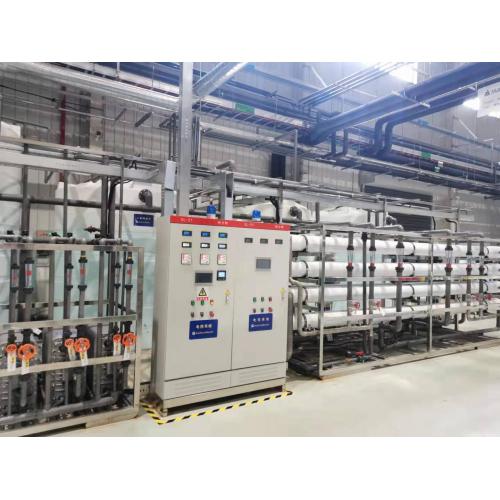
Ultrapure Water Secondary Reverse Osmosis Polishing Resin
- Min. Order:
- 1 Set/Sets
- Min. Order:
- 1 Set/Sets
- Transportation:
- Ocean, Land
- Port:
- Shanghaigang
Quantity:
Your message must be between 20 to 2000 characters
Contact NowBasic Info
Basic Info
| Place of Origin: | China Jiangsu |
|---|---|
| Productivity: | 200 sets |
| Supply Ability: | Annual output of 200 sets of water treatment equipment or even more |
| Payment Type: | L/C,T/T |
| Incoterm: | FOB,CIF |
| Certificate: | AAA certification |
| Transportation: | Ocean,Land |
| Port: | Shanghaigang |
Product Description
Product Description
Product Description
Introduction to EDI ultrapure water equipment: EDI ultrapure water treatment equipment is an electrodeionization system, a new technology for the preparation of ultrapure water (high purity water) that organically combines electrodialysis membrane separation technology and ion exchange technology. It uses electricity The polarization phenomenon in the dialysis process electrochemically regenerates the ion exchange resin filled in the fresh water chamber. This equipment is mainly under the action of a direct current electric field, the water dielectric ions passing through the partition undergo directional movement, and the selective permeation effect of the exchange membrane on the ions is used to purify the water quality.
The basic working principle of EDI
EDI is a pure water manufacturing technology that combines ion exchange technology, ion exchange membrane technology and ion electromigration technology (electrodialysis technology). This technology uses ion-exchange energy for deep desalination to overcome electrodialysis polarization and incomplete desalination, and uses electrodialysis polarization to produce water ionization to produce H+ and OH-. These ions continuously regenerate the ion exchange resin to make the ion exchange resin Keep it at its best.
The EDI membrane stack is mainly composed of alternately arranged cation exchange membranes, concentrated water chambers, anion exchange membranes, fresh water chambers and positive and negative electrodes. The ion exchange resin is filled and sandwiched between the anion and cation exchange membranes to form a single treatment unit and constitute a fresh water chamber. The units are separated by a mesh to form a concentrated water chamber. Under the action of a direct current electric field, the cations and anions in the ion exchange resin in the fresh water compartment migrate to the negative and positive electrodes along the channel formed by the resin and the membrane, respectively. The cations pass through the cation exchange membrane, and the anions pass through the anion exchange membrane and enter the Concentrated water is formed in the water chamber. At the same time, the cations and anions in the EDI inlet water are exchanged with the hydrogen ions and hydroxide ions in the ion exchange resin to form ultrapure water (high purity water). The ultra-limiting current enables a large amount of hydrogen ions and hydroxide ions produced by water electrolysis to continuously regenerate the ion exchange resin. Traditional ion exchange requires chemical intermittent regeneration after the ion exchange resin is saturated. The resin in the EDI membrane stack is continuously regenerated through the electrolysis of water, and the work is continuous, without the need for acid-base chemical regeneration.
The EDI device divides the feed water into three independent water streams: pure water, concentrated water, and extreme water. Pure water (90%-95%) is the final water, concentrated water (5%-10%) can be recycled, and the extreme water (1%) is discharged.
Features of EDI device
The EDI device does not require chemical regeneration and can be operated continuously, and thus does not require the acid-base solution required for the regeneration of the mixed ion exchange equipment of the traditional water treatment process, and the wastewater discharged from the regeneration. Its main features are as follows:
The basic process of EDI water purification:
(1) Continuous operation, stable product water quality
(2) Easy to realize fully automatic control
(3) No need to regenerate with acid and alkali
(4) No downtime due to regeneration, saving reclaimed water and reclaimed sewage treatment facilities
(5) High water production rate (up to 95%).
The EDI device is a refined water treatment system, and is generally used in conjunction with reverse osmosis (RO) to form an ultrapure water treatment system of pretreatment, reverse osmosis, and EDI devices, replacing the mixed ion exchange equipment of the traditional water treatment process. The water inlet requirement of the EDI device is 0.025-0.5MΩ·cm in resistivity, and the reverse osmosis device can fully meet the requirements. The EDI device can produce ultrapure water with a resistivity of more than 15MΩ·cm.
For high-purity water systems, the reverse osmosis + EDI process is an ideal choice regardless of the water quality, performance and operation considerations, or operating costs and environmental protection considerations.

The basic working principle of EDI
EDI is a pure water manufacturing technology that combines ion exchange technology, ion exchange membrane technology and ion electromigration technology (electrodialysis technology). This technology uses ion-exchange energy for deep desalination to overcome electrodialysis polarization and incomplete desalination, and uses electrodialysis polarization to produce water ionization to produce H+ and OH-. These ions continuously regenerate the ion exchange resin to make the ion exchange resin Keep it at its best.
The EDI membrane stack is mainly composed of alternately arranged cation exchange membranes, concentrated water chambers, anion exchange membranes, fresh water chambers and positive and negative electrodes. The ion exchange resin is filled and sandwiched between the anion and cation exchange membranes to form a single treatment unit and constitute a fresh water chamber. The units are separated by a mesh to form a concentrated water chamber. Under the action of a direct current electric field, the cations and anions in the ion exchange resin in the fresh water compartment migrate to the negative and positive electrodes along the channel formed by the resin and the membrane, respectively. The cations pass through the cation exchange membrane, and the anions pass through the anion exchange membrane and enter the Concentrated water is formed in the water chamber. At the same time, the cations and anions in the EDI inlet water are exchanged with the hydrogen ions and hydroxide ions in the ion exchange resin to form ultrapure water (high purity water). The ultra-limiting current enables a large amount of hydrogen ions and hydroxide ions produced by water electrolysis to continuously regenerate the ion exchange resin. Traditional ion exchange requires chemical intermittent regeneration after the ion exchange resin is saturated. The resin in the EDI membrane stack is continuously regenerated through the electrolysis of water, and the work is continuous, without the need for acid-base chemical regeneration.
The EDI device divides the feed water into three independent water streams: pure water, concentrated water, and extreme water. Pure water (90%-95%) is the final water, concentrated water (5%-10%) can be recycled, and the extreme water (1%) is discharged.
Features of EDI device
The EDI device does not require chemical regeneration and can be operated continuously, and thus does not require the acid-base solution required for the regeneration of the mixed ion exchange equipment of the traditional water treatment process, and the wastewater discharged from the regeneration. Its main features are as follows:
The basic process of EDI water purification:
(1) Continuous operation, stable product water quality
(2) Easy to realize fully automatic control
(3) No need to regenerate with acid and alkali
(4) No downtime due to regeneration, saving reclaimed water and reclaimed sewage treatment facilities
(5) High water production rate (up to 95%).
The EDI device is a refined water treatment system, and is generally used in conjunction with reverse osmosis (RO) to form an ultrapure water treatment system of pretreatment, reverse osmosis, and EDI devices, replacing the mixed ion exchange equipment of the traditional water treatment process. The water inlet requirement of the EDI device is 0.025-0.5MΩ·cm in resistivity, and the reverse osmosis device can fully meet the requirements. The EDI device can produce ultrapure water with a resistivity of more than 15MΩ·cm.
For high-purity water systems, the reverse osmosis + EDI process is an ideal choice regardless of the water quality, performance and operation considerations, or operating costs and environmental protection considerations.

Related Keywords
Related Keywords














